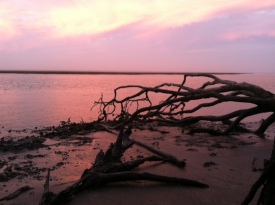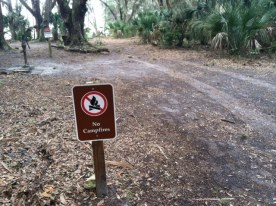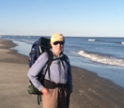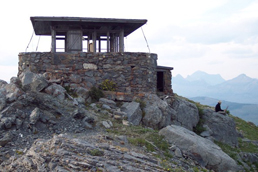You are currently browsing the category archive for the ‘National Park Service’ category.
by Jerome Walker
 In February, the weather is usually perfect on Georgia’s coastal islands. That’s one of the reasons why America’s wealthiest men formed the exclusive Jekyll Island Club during the late 1800’s and turned that island into a Gilded Age playground. Every winter they repaired to their “cottages” on Jekyll to hunt, fish, play golf and tennis, sail, and otherwise divert themselves. It’s rumored that poor Thomas Carnegie wanted to join the club, but because he and his brother Andrew came to this country as penniless teenagers from Scotland, they were supposedly turned away. Whether this story is true or not, in 1884 Thomas Carnegie purchased most of Cumberland Island, just south of Jekyll Island. He and his wife Lucy then proceeded to build a complex of lavish mansions there. Today, 17 mile-long Cumberland Island, larger than Manhattan Island, is a National Seashore, administered by the National Park Service. Along with places like Yellowstone and the Grand Canyon, it’s been designated a World Heritage Center by the United Nations for its unique natural beauty. Roughly the northern half of the island is a federally designated Wilderness.
In February, the weather is usually perfect on Georgia’s coastal islands. That’s one of the reasons why America’s wealthiest men formed the exclusive Jekyll Island Club during the late 1800’s and turned that island into a Gilded Age playground. Every winter they repaired to their “cottages” on Jekyll to hunt, fish, play golf and tennis, sail, and otherwise divert themselves. It’s rumored that poor Thomas Carnegie wanted to join the club, but because he and his brother Andrew came to this country as penniless teenagers from Scotland, they were supposedly turned away. Whether this story is true or not, in 1884 Thomas Carnegie purchased most of Cumberland Island, just south of Jekyll Island. He and his wife Lucy then proceeded to build a complex of lavish mansions there. Today, 17 mile-long Cumberland Island, larger than Manhattan Island, is a National Seashore, administered by the National Park Service. Along with places like Yellowstone and the Grand Canyon, it’s been designated a World Heritage Center by the United Nations for its unique natural beauty. Roughly the northern half of the island is a federally designated Wilderness.
Since Cumberland Island now belongs to the American public, who purchased it from the private owners, in early February of last year my wife and I decided to check on our property by making a three day-back-pack. It was her first visit to the island, and we especially wanted to visit Cumberland Island Wilderness, and also visit Carol Ruckdeschel, a renowned biologist who lives on the island. For decades, Carol has fiercely protected both the island and the endangered sea turtles who nest on its beaches every summer. Carol is part of the fascinating history of Cumberland Island, and has been written about by a number of writers, including John McPhee. The most recent, and probably best account of her efforts to keep Cumberland wild, is Will Harlan’s book “Untamed: The Wildest Woman in America and the Fight for Cumberland Island,” which was published by Grove Press this past May.
After spending the night in St. Marys, a sleepy fishing village on the southeast tip of Georgia’s coast, we boarded the early morning Park Service ferry for the 45 minute ride to the island. Pelicans and gulls flew overhead and dolphins played in the ferry’s bow wave. After a brief orientation at Sea Camp Ranger Station — which used to be developer Charles Fraser’s headquarters when he had plans to turn the island into another Hilton Head — we started walking north towards the Wilderness. Along the way we passed near Greyfield, one of the mansions built as wedding gifts for Thomas and Lucy Carnegie’s children. Now it’s an inn run by some of the Carnegie descendants.
 A little over a decade ago, on a backpack with friends, I witnessed the Park Service driving a pickup truck through the wilderness area, and later saw a truck load of guests staying at Greyfield Inn being taken on a motorized commercial tour through the Wilderness. Soon thereafter, the Park Service, with the blessing of The Wilderness Society and National Parks Conservation Association, began conducting its own motorized visitor tours using 15-passsenger vans. When this was reported to Wilderness Watch’s founder Bill Worf, he was incredulous and came to Georgia himself to check it out. Later, in 2004, Wilderness Watch brought suit against the Park Service and won in the Eleventh Circuit U.S. Court of Appeals. A three judge panel ruled unanimously that of course driving in Wilderness was illegal. Unfortunately, this victory was short-lived, as the local Republican Congressman, Jack Kingston, quietly tacked a rider onto an omnibus spending bill in Congress later that same year. His rider removed the unpaved single lane main road that runs the length of the island and also the entire beach from the Wilderness. This was the first time, and hopefully the last, that Wilderness had ever been removed from the National Wilderness Preservation System without public input.
A little over a decade ago, on a backpack with friends, I witnessed the Park Service driving a pickup truck through the wilderness area, and later saw a truck load of guests staying at Greyfield Inn being taken on a motorized commercial tour through the Wilderness. Soon thereafter, the Park Service, with the blessing of The Wilderness Society and National Parks Conservation Association, began conducting its own motorized visitor tours using 15-passsenger vans. When this was reported to Wilderness Watch’s founder Bill Worf, he was incredulous and came to Georgia himself to check it out. Later, in 2004, Wilderness Watch brought suit against the Park Service and won in the Eleventh Circuit U.S. Court of Appeals. A three judge panel ruled unanimously that of course driving in Wilderness was illegal. Unfortunately, this victory was short-lived, as the local Republican Congressman, Jack Kingston, quietly tacked a rider onto an omnibus spending bill in Congress later that same year. His rider removed the unpaved single lane main road that runs the length of the island and also the entire beach from the Wilderness. This was the first time, and hopefully the last, that Wilderness had ever been removed from the National Wilderness Preservation System without public input.
Later that day, we passed another luxurious Carnegie mansion, Plum Orchard, which the Park Service has renovated at considerable expense for daily tours. At 25,000 square feet with countless bedrooms, an indoor pool and squash court, a huge formal dining room, a “gun room” for the men, and an enormous staff of servants, it was a wedding gift to Thomas and Lucy’s son George, who enjoyed it only for a few months each year. Finally, we reached the wilderness boundary and spent our first night in Yankee Paradise, one of three designated wilderness camping areas. The next day we hiked under huge live-oak trees dripping Spanish moss to our next campsite at Brickhill Bluff, which overlooks the marshes between the island and the mainland. After setting up our tent, we continued hiking to the north end of the island. This is a small area beyond the wilderness boundary shared by Carol’s modest cabin, the historic one room First African Baptist Church, established in 1893, and a private complex owned by the Candlers, heirs of the inventor of Coca-Cola. We spent a very pleasant afternoon sitting on Carol’s porch, marveling at the pet animals, including several buzzards, that live there with Carol, and talking about the challenges of keeping the island protected, which are explained in an excellent website that Carol writes, http://www.wildcumberland.org.
 Jerome Walker’s introduction to Wilderness Watch and Wilderness began when his late wife, Melissa, author of Living on Wilderness Time, served 10 years on WW’s board, including a term as vice president. A retired neurologist who specialized in groundbreaking headache research and treatment, Jerome has concentrated on wilderness photography for the last two decades. He has photographed wild country from Alaska to Florida, traveling on foot and by canoe. Jerome’s images have been displayed in galleries and currently are in private and corporate collections throughout the country. They have been used in books, newsletters, calendars and are on his website (jeromewalkerphotography.com). His time in Wilderness has led him to recognize its fragility and has motivated his work to protect it. He lives in Missoula, MT.
Jerome Walker’s introduction to Wilderness Watch and Wilderness began when his late wife, Melissa, author of Living on Wilderness Time, served 10 years on WW’s board, including a term as vice president. A retired neurologist who specialized in groundbreaking headache research and treatment, Jerome has concentrated on wilderness photography for the last two decades. He has photographed wild country from Alaska to Florida, traveling on foot and by canoe. Jerome’s images have been displayed in galleries and currently are in private and corporate collections throughout the country. They have been used in books, newsletters, calendars and are on his website (jeromewalkerphotography.com). His time in Wilderness has led him to recognize its fragility and has motivated his work to protect it. He lives in Missoula, MT.
by Kevin Proescholdt
 I recently came across an on-line forum asking whether “snow kiting” is allowed in Wilderness. While snow kiting in Wilderness might still be a rather rare activity, the question bears quite heavily on a variety of activities and the future of the National Wilderness Preservation System.
I recently came across an on-line forum asking whether “snow kiting” is allowed in Wilderness. While snow kiting in Wilderness might still be a rather rare activity, the question bears quite heavily on a variety of activities and the future of the National Wilderness Preservation System.
For those unfamiliar with the sport, snow kiting is an offshoot of kiteboarding (a water sport), but conducted on land and on snow. Like kiteboarders, snow kiters use large inflatable kites – some are similar to parasails – that allow the wind to pull them along or to jump and glide in the air for seconds at a time. Kite lines run to a snow kiter’s harness and handle, which are used to maneuver the kite. Though many snow kiters use snowboards, some telemark and alpine skiers also use kites as part of their sport.
Snow kiting in units of the wilderness system seems to have increased in recent years. But I believe snow kiting violates the Wilderness Act, even though the federal agencies have been slow in writing specific rules spelling out such a ban. I hope that soon, before this use becomes too entrenched in units of the wilderness system, all four agencies will ban snow kiting in Wilderness for two main reasons.
First, snow kiting violates the Wilderness Act, most notably its ban on mechanical transport in Wilderness. U.S. Forest Service wilderness policy comes close to articulating a ban on snow kiting, by prohibiting (among other banned mechanical transport) hang gliders and parachutes, which are similar to snow kiting:
Forest Service Manual 2320.5
Mechanical Transport. Any contrivance for moving people or material in or over land, water, or air, having moving parts, that provides a mechanical advantage to the user, and that is powered by a living or nonliving power source. This includes, but is not limited to, sailboats, hang gliders, parachutes, bicycles, game carriers, carts, and wagons.
At least some of these specific prohibitions have held up in the courts. A federal court upheld a Forest Service ban on sailboats on wilderness lakes, for example, in one of a series of court cases involving the Sylvania Wilderness in the Upper Peninsula of Michigan. The 6th Circuit Court of Appeals wrote in this case, “Certainly, Congress could rationally conclude that certain forms of mechanical transport, including sailboats and houseboats, should be excluded from the Sylvania Wilderness in order to preserve the ‘wilderness character’ of the property.”
The National Park Service also appears to have prohibited snow kiting in Wilderness, though under its regulations that govern aircraft (snow kiting meets its definition of aircraft in the Code of Federal Regulations) and “aerial delivery,” and not under its regulations prohibiting mechanical transport in Wilderness. As a result, the Park Service has prohibited snow kiting in Glacier National Park’s Recommended Wilderness as well as in other national park Wildernesses.
In addition to violating the ban on mechanized travel, snow kiting runs against the grain of the types of recreation the Wilderness Act sought to provide. The law defines Wilderness in part as providing “a primitive and unconfined type of recreation….” Snow kiting is clearly not this type of primitive recreation envisioned by the Wilderness Act.
Second, beyond the legal violations, snow kiting should be banned in Wilderness because the activity makes Wildernesses less wild. This is not about snow kiting’s physical impacts on Wilderness, but about our relationship to Wilderness. Snow kiting is a modern transportation method, not one envisioned by the founders of the Wilderness Act or the ideals behind it. It is not travel by primitive means. It ignores the humility and restraint that Wilderness Act author Howard Zahniser urged us to use in our relationship to Wilderness.
Wilderness is in part about preserving and experiencing these places from an earlier time and an earlier pace of travel, such as by foot, horseback, or canoe. According to the Wilderness Act, designated Wildernesses are to be “in contrast with those areas where man and his works dominate the landscape….” If snow kiting and other yet-to-be-created transportation means are allowed in Wilderness, that contrast will be increasingly diminished and indistinct, and Wilderness will cease to be that special place set apart from modern civilization. I believe that we must stand up for that distinction or we open the door to untold and unforeseen levels of non-human- or non-animal-powered transportation in Wilderness, making Wilderness little different from the rest of our human-dominated landscape.
I understand the concern expressed by some that any restrictions short of an outright ban on all mechanical devices (including, for example, a ski binding) would be somewhat arbitrary. But it seems that the most reasonable, protective, and defensible rule is one rooted in the methods of travel in common use at the time the Wilderness Act was passed. This is the approach a federal court took when several members of the Chippewa (also called Ojibwe or Anishinaabe) tribe challenged the prohibition on snowmobile use while exercising their treaty rights to fish in the Boundary Waters Canoe Area Wilderness in Minnesota. The court relied on the fact that Band members traditionally accessed the area by canoe or on foot at the time of the 1854 treaty, and therefore the Wilderness Act’s ban on modern snowmobiles didn’t constitute an infringement on treaty rights.
If we don’t keep wilderness protections anchored to something solid like the primitive modes of travel contemplated in the law, what’s to protect Wilderness from any whimsical fad, recreational pursuit, or technological advance that comes its way?
Kevin Proescholdt is conservation director (and former board president) for Wilderness Watch. He has written extensively on the Boundary Waters, and wilderness policy and history.
 Glacier National Park recently decided to move forward with its plan to stabilize the non-operational Heavens Peak Lookout, within recommended wilderness, despite the objections of Wilderness Watch, two retired Glacier NP rangers, and the majority of those who commented on the environmental assessment. The project includes the use of a helicopter (up to 12 flights) and a generator. Wilderness Watch objected to the plan based on its disregard for the Wilderness Act (which prohibits structures and the use of motorized vehicles/mechanized equipment in Wilderness) and Park Service policy (which requires recommended wilderness to be managed as Wilderness).
Glacier National Park recently decided to move forward with its plan to stabilize the non-operational Heavens Peak Lookout, within recommended wilderness, despite the objections of Wilderness Watch, two retired Glacier NP rangers, and the majority of those who commented on the environmental assessment. The project includes the use of a helicopter (up to 12 flights) and a generator. Wilderness Watch objected to the plan based on its disregard for the Wilderness Act (which prohibits structures and the use of motorized vehicles/mechanized equipment in Wilderness) and Park Service policy (which requires recommended wilderness to be managed as Wilderness).
A local newspaper article stated that opposition to the project was based on, “the belief (emphasis added) that preservation of cultural resources and the use of helicopters are not permitted by the Wilderness Act,” when in fact, opposition was based on NPS wilderness policy and federal law. A Wilderness Watch member and former Glacier National Park biologist responded to the article with this excellent Op Ed:
The Inter Lake article “Glacier Park lookout restoration gets green light” (9 June) did not accurately describe the reasons for broad opposition to this project. The article stated: “most opposed it based on the belief that preservation of cultural resources and the use of helicopters are not permitted by the Wilderness Act.” It is not a question of “belief.” At issue is the accurate interpretation of the letter and intent of the Wilderness Act. Glacier National Park already has proposed this lookout area for inclusion in legal Wilderness. Although a Civilian Public Service crew built the lookout, they simply provided the labor. Put a plaque in a visitor center acknowledging the crew. But are the crumbling ruins of the Heavens Peak Lookout, built in 1945 and used for only a few years, a cultural resource of such significance that it trumps the values of Wilderness? The Wilderness Act does not permit unnecessary agency use of a helicopter; can helicopter use be justified for this project as if it were essential, e.g., has the same importance as a rescue mission? The decision to approve the project is based on elevating a minor cultural resource to importance it does not warrant and cavalierly dismissing impacts to wilderness values.
This confusing duplicity is nothing new. The National Park Service (NPS) did not support the inclusion of national parks in the Wilderness System when the Act was signed in 1964 and the agency has never demonstrated a commitment to the Act. NPS Historian Richard Sellers has written: “Although many of the National Park Service’s rank and file enthusiastically supported the wilderness bill, the bureau’s leadership seems to have drifted from outright opposition to reluctant neutrality.” The NPS has made this shift by conveniently writing inordinate flexibility into its management standards.
Eight years after passage of the Wilderness Act, the NPS advocated Wilderness classification for Glacier. However, Director Hartzog and Glacier Superintendent Briggle wanted the proposal to include an aerial tram or gondola route from the Many Glacier Hotel to Grinnell Glacier, and new “wilderness” chalets within 100-acre enclaves at Cosley Lake, Debris Creek, Fifty Mountain, and the head of Kintla Lake. Public opposition sunk these schemes.
The NPS proclaims that helicopter flights, a generator, and other activities associated with the lookout reconstruction will have “No Significant Impact” on the environment or on wilderness characteristics. This conclusion is not supported by the facts. A careful reading of the Environmental Assessment (EA) reveals that short shrift is given to impacts on visitor experiences, natural quiet, natural landscapes, and wildlife. Even when the reconstruction work has been completed, insults will continue with periodic helicopter flights for maintenance. There is no plan to actually “use” the rebuilt lookout. Rather than the old structure continuing to gradually disintegrate, the restored lookout will serve as a permanent blemish on the ridge skyline.
According to the EA, the NPS does not plan to reconstruct the trail to the lookout because it is within the area of highest density of grizzly bears in the Northern Continental Divide Ecosystem. Yet we are told that construction workers will bushwhack from Packers Roost to a construction camp. Inevitably, hikers will bushwhack their way to see this intrusive monument. Is this responsible management of prime grizzly habitat? The route from the planned camp to the Lookout is up a steep talus slope, where the trail will have to be reconstructed to avoid multiple erosion scars. Current NPS wilderness management policy (available on the internet) stresses the importance of determining whether a proposed project has an adverse impact on the preservation of natural conditions including the lack of man-made noises, the assurance of outstanding opportunities for solitude, and the assurance that wilderness will be preserved and used in an unimpaired condition. The basic policy is clear and the Heavens Peak Project does not meet the policy’s criteria for approval. However, the NPS relies on policy exceptions that apparently allow a superintendent to conjure up justifications for antithetical projects such as Heavens Peak.
Wilderness qualities, and the opportunity for visitors to appreciate and enjoy wilderness, depend on the standards by which an area is managed, not simply on naming an area “Wilderness,” as Superintendent Cartwright advocates.
Riley McClelland, West Glacier

You must be logged in to post a comment.